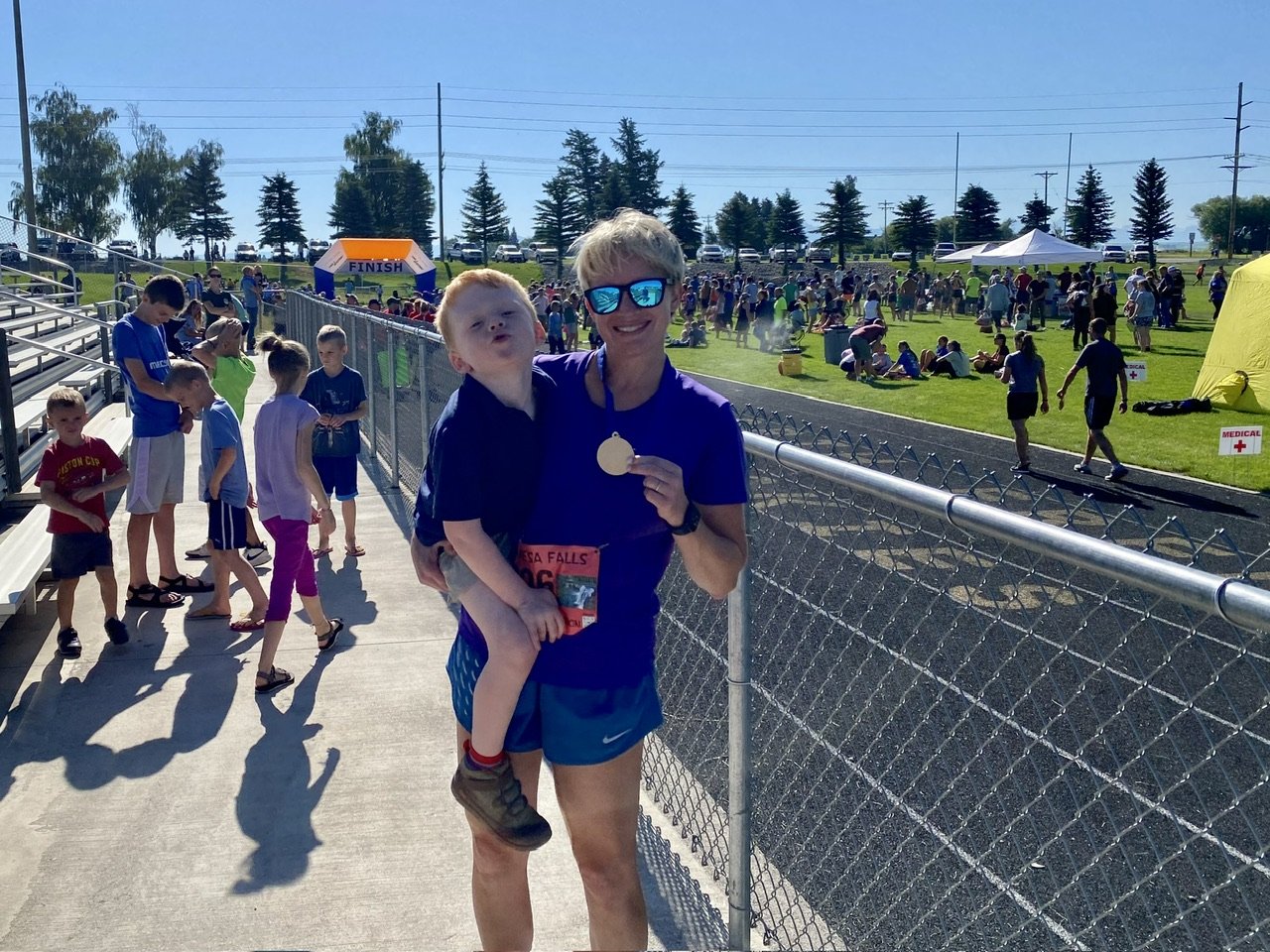Racing Toward Imperfection
July 28, 2023
Don't run the Mesa Falls Half Marathon if you want to finish the race in front of a huge crowd. But if you’re in search of a scenic, challenging course with a small-town vibe, consider adding this Ashton, Idaho event to your list. And for state 27 of 50 in my late sister’s honor, that’s exactly what I did.
Mesa Falls marked my second half marathon and third race since I had reconstructive ankle surgery in January 2022. The point-to-point course begins in Targhee National Forest near the headwaters of the Warm River. If I’d bothered to read the course description or reviews, I may have been better prepared for the first three or four miles on a gnarly trail that runs parallel to the river and snakes through a campground before ascending sharply to a paved road. (Note: I’ve shredded both ankles enough that my doctors told me to retire from trail running.) The last six-odd miles are in wide-open space with zero shade and intermittent water stations. The terrain, heat (high temp on race day: 91 degrees) and altitude made for my first real postoperative test.
I often ask my sister, Taylor, for strength when I’m racing. And in Idaho farm country, I needed it.
Learning from Failure
In 2017, after missing my goal time by a long shot at the Missoula Half Marathon, I wrote about the importance of failure. I was a young 35: lean, mean and not yet a mother. That week in Montana, in addition to running a race, I worked the local media circuit, signed a publishing contract for Run to the Light and practiced for the TED talk I’d deliver in the fall.
My sister was also still alive, and while Taylor didn’t care about my performance, I wanted to run faster than I’d ever run for her.
Even if you didn’t read my recap of Missoula, you can guess what comes next in the story: I bombed my sub-1:40 half marathon attempt, missing my goal by a whopping 10 minutes. I couldn’t even figure out why I failed. My legs just didn’t cooperate.
If you did read that blog, however, you may remember the Winston Churchill quote I used:
“Success is not final, failure is not fatal: it is the courage to continue that counts.”
The truth is that I’ve had many failures, most of them more consequential than an arbitrary half marathon finish time. I’ve even failed multiple times since I opened my eyes early this morning. I brewed a good (not great) pot of coffee. I arrived two minutes late for a meeting. I pruned the hydrangea tree in my backyard and took a little too much. I stared at a blank page for five minutes before typing a single word of this blog post.
Living life as an imperfect human in an imperfect world isn’t easy. But if I stop to think about it, whenever I’ve fallen short of a goal or made a mistake, I’ve come out OK on the other side. Sometimes, if I let it happen, I even emerge stronger.
Seeing the Good in the Not-So-Bad
I’m a perfectionist, so failing at anything, even by my own impossible standards, can be a living nightmare. In a 2022 study, Florida State University researchers defined perfectionism as “‘refusing to accept’ anything short of ‘being flawless.’” They went on to imply that an unquenchable drive for precision might actually impair performance. The researchers studied a group of 76 undergraduates, giving them a series of tests designed to be difficult and, in some cases, impossible. Then, things got interesting: These engineered “failures” actually helped the participants feel better about their mistakes and even lowered their overall levels of perfectionism.
While this small study wasn’t exactly groundbreaking, it is an interesting way to think about seeing the good in the maybe not-so-bad. I’ve been working to improve this important skill since long before my sister died in 2018. But that year, I also became a parent. And as any parent reading this can understand, I had to put aside many of my own relentless pursuits to care for the tiny human who depended on me to survive then … and still does almost five years later.
My running career, for one, certainly changed once Jack was born. Now, weekend long runs require advance planning and cooperation from Jack’s dad. I think twice about overtraining, which could lead to injury and affect my ability to keep up with a high-energy child. I also plan many of my races around taking my family with me.
Sometimes I miss my former 50-mile-week life. I can’t deny that traveling all over the country for races was much easier and cheaper when I was childless. My once meticulous race week prep takes a second seat to parenting. I’m also not getting any younger — hello, masters division!
But gosh, as many runners with children know, there’s nothing quite like getting a bear hug from your baby at the finish line. Jack was just six weeks old when I buried my face in his fuzzy bodysuit at the finish line of the Charlotte Half Marathon in 2018. I’ll never forget that feeling, but I’ve come close to it again many times as my little boy has gotten older. And though I didn’t run this month’s Mesa Falls Half Marathon as fast as I would have liked, I’d trade a thousand PRs for the sight of Jack’s smile and the sound of him shouting, “Mommy!” at the end of a difficult 13.1 miles.
What’s Next
So, what’s next in this beautifully imperfect story? As races go, that’d be December’s Kiawah Island Half Marathon, where I’ll attempt to break the world record for fastest blindfolded half marathon by a female. To succeed, I’ll need a near-flawless performance.
Until then, I’ll be working to embrace my many imperfections. Accepting them may just be my key to success.


